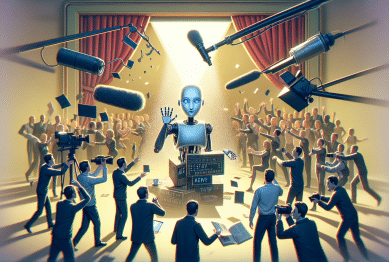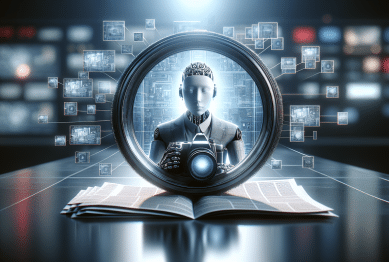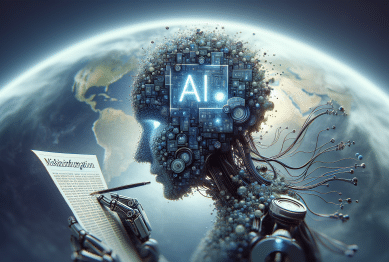AI election deepfakes are shaking global news and public perception. This guide explores what recent advances in artificial intelligence mean for information accuracy, voting, and trust in the media. Learn what’s at stake for the public, and how both experts and citizens are responding.
The Rise of AI Deepfakes in Election News
The explosion of AI-generated deepfakes has changed the way news unfolds around elections worldwide. Today, sophisticated algorithms can craft convincing videos, voice recordings, and images that mimic real politicians or events. It’s unsettling—stunningly realistic content spreads across major platforms before fact-checkers can assess the authenticity. These deepfakes aren’t just curiosities; they raise urgent questions about media trust, especially as voters turn to online news for up-to-the-minute updates (Source: https://www.nytimes.com/2023/10/22/technology/deepfakes-politics-elections.html).
As election cycles intensify, the sophistication of deepfake technology keeps pace with public demand for breaking news. In 2024, several countries reported synthetic campaign speeches and altered debates circulating rapidly on social media. Not all viewers immediately spot the difference. Many trust what they see and hear, leading to confusion or even manipulation of public sentiment. The impact: some candidates face reputational risks based not on their actual words, but on viral fabrications.
This new wave of misinformation calls for urgent response. Public interest in the keyword ‘AI election deepfakes’ has skyrocketed on search engines. Citizens want to know how these stories might affect election outcomes, and whether the institutions they rely on are adequately equipped to verify digital evidence. As AI tools spread, understanding the basics behind this technology becomes critical—not just for tech experts, but for every voter.
How Deepfakes Are Made and Detected
Creating a convincing deepfake once required advanced skills and custom hardware. Now, software packages make synthetic media accessible to anyone with internet access. Algorithms such as generative adversarial networks (GANs) analyze thousands of images or audio clips, learning to replicate faces, voices, and gestures. Once a neural network makes enough progress, it produces content nearly indistinguishable from genuine footage. The result: fake speeches, interviews, and political ads can be produced in hours instead of months.
Fortunately, detection tools are advancing too. Leading tech firms and universities deploy specialized AI to flag manipulated media by looking for digital inconsistencies invisible to the naked eye. Trained models spot anomalies in pixelation, subtle lip-sync errors, or strange eye movements common in synthetic videos. User reporting mechanisms on major social media platforms help, but identifying a well-made deepfake still often requires expert review and sometimes a coordinated response from journalistic organizations (Source: https://blog.google/technology/ai/google-ai-tools-combat-deepfakes/).
Rapid advances mean the cat-and-mouse game between creators and detectors remains heated and dynamic. Even experienced viewers can be fooled if a deepfake is rushed into the news cycle at a critical election moment. That’s why ongoing collaboration between journalists, technology providers, and fact-checking groups is essential when combating information pollution in the digital age.
Impacts on Public Trust and Election Outcomes
Trust in the media has always been vital in democratic systems. The proliferation of AI deepfakes, however, undermines that foundation. When synthetic media aligns with personal biases, it’s more likely to be believed and shared. This amplifies echo chambers and distorts the information voters use to make choices. After all, if doctored videos are indistinguishable from reality, what can the public trust? Data from Pew Research Center shows rising concern: in recent polls, a majority of respondents cited AI misinformation as a major threat to fair elections (Source: https://www.pewresearch.org/fact-tank/2023/12/12/americans-fear-deepfakes-election/).
Election interference is not hypothetical. Several documented cases saw altered media presented as evidence against politicians or used to stoke division among communities. The psychological impact is sizable; doubt seeps into the public consciousness, coloring the legitimacy of election results. Not all those exposed to fake content become misled, but some shift opinions or become cynical about the news itself. The result: voter disengagement or polarization, both of which threaten democratic norms and processes.
Countering this challenge requires public education and institutional transparency. News organizations increasingly share insights about their verification process and explain when footage may be questionable. National election commissions regularly issue updates and advisories urging citizens to verify questionable content through official portals or fact-checking hubs (Source: https://www.eac.gov/news/2024/03/15/responding-deepfakes-election).
Policy Responses: What Are Governments Doing?
Governments worldwide recognize the risk posed by AI deepfakes to news integrity and electoral fairness. New rules and guidance are being drafted at national and international levels to combat misinformation. Some countries require social media sites to label or remove manipulated content, while others mandate transparency from creators of synthetic media. The European Union’s Digital Services Act, for instance, introduces strict responsibilities for tech platforms regarding deepfake detection and removal (Source: https://ec.europa.eu/commission/presscorner/detail/en/ip_22_6428).
These laws are not always universally embraced. Civil liberties advocates caution against excessive government filtering or potential censorship. Policymakers must find a balance—protecting elections while preserving the open exchange of ideas online. In the U.S., federal agencies collaborate with major technology firms to test best practices that protect freedom of speech while restricting coordinated disinformation campaigns during voting seasons (Source: https://www.dhs.gov/news/2024/01/10/dhs-launches-ai-task-force-election-security).
The landscape is still evolving. As more cases appear, new regulatory ideas and pilot projects are being tested—such as digital watermarks or AI-generated verification tools. Global cooperation, particularly for elections impacted by foreign interference, becomes increasingly important. Continuous dialogue between technology companies, civil society, and election bodies is necessary to adapt quickly to these emerging threats.
What Citizens Can Do: Staying Critical and Informed
Individual vigilance is crucial in an era of AI-powered news. Citizens can limit the spread of deepfakes by double-checking sources, relying on established news organizations, and being wary of sensational or too-good-to-be-true stories. Many fact-checking portals provide detailed breakdowns of viral videos or trending claims. Checking several sources before sharing information is a habit that reduces the reach of manufactured disinformation (Source: https://www.firstdraftnews.org/latest/deepfakes-voters-election/).
Media literacy programs have emerged as a response to AI election deepfakes. Schools, libraries, and nonprofits now teach people how to spot visual and audio inconsistencies in digital media. Public service campaigns often urge skepticism toward anonymous uploads and encourage reporting of suspicious material. This educational focus empowers communities by making voters aware of both the threat and the tools available for self-defense in the information ecosystem.
While technology plays a key role, human judgment remains vital. AI-based detection can flag suspicious content, but understanding political context and media history enriches vigilance. Granular awareness, critical thinking skills, and open conversation with trusted peers ensure that the impact of deepfakes is minimized—even in high-tension election periods. Ultimately, an informed audience is the best defense against manipulation.
Looking Ahead: The Future of Elections in the AI Era
The evolution of AI in news and elections shows no signs of slowing down. With each cycle, technology improves, and so do the methods for both generating and detecting deepfakes. Experts predict increasing investment into research and collaboration between governments, tech firms, and universities. Young voters, in particular, are adapting to this new media reality by using multiple channels and advanced search techniques to verify political content (Source: https://www.brookings.edu/articles/elections-in-the-age-of-artificial-intelligence/).
One promising trend is the integration of cryptographic signatures and watermarking for authentic news content. If adopted widely, these standards could make it easier to verify whether videos and images originate from reputable sources. Nevertheless, there are ongoing debates about privacy, implementation cost, and the need to avoid burdening legitimate users or stifling innovation.
The message is clear: the struggle over AI election deepfakes is far from over. Protecting democratic choices will require adaptability, robust technology, and above all, an informed and critical public. Staying aware of the evolving landscape—and the real issues at stake as deepfakes enter global election news cycles—remains a top priority for everyone interested in the future of democracy.
References
1. New York Times. (2023). Deepfake Videos Threaten Elections. Retrieved from https://www.nytimes.com/2023/10/22/technology/deepfakes-politics-elections.html
2. Google. (2023). New AI Tools to Combat Deepfakes. Retrieved from https://blog.google/technology/ai/google-ai-tools-combat-deepfakes/
3. Pew Research Center. (2023). Americans Are Worried About Deepfakes and Elections. Retrieved from https://www.pewresearch.org/fact-tank/2023/12/12/americans-fear-deepfakes-election/
4. U.S. Election Assistance Commission. (2024). Responding to Deepfakes. Retrieved from https://www.eac.gov/news/2024/03/15/responding-deepfakes-election
5. European Commission. (2022). Digital Services Act Explained. Retrieved from https://ec.europa.eu/commission/presscorner/detail/en/ip_22_6428
6. Brookings Institution. (2023). Elections in the Age of Artificial Intelligence. Retrieved from https://www.brookings.edu/articles/elections-in-the-age-of-artificial-intelligence/









